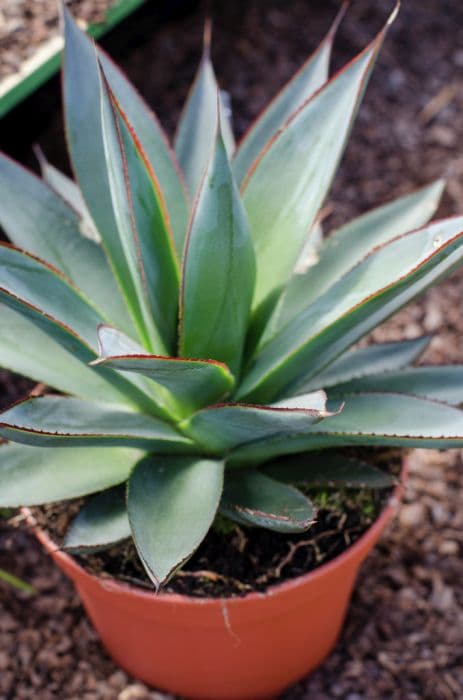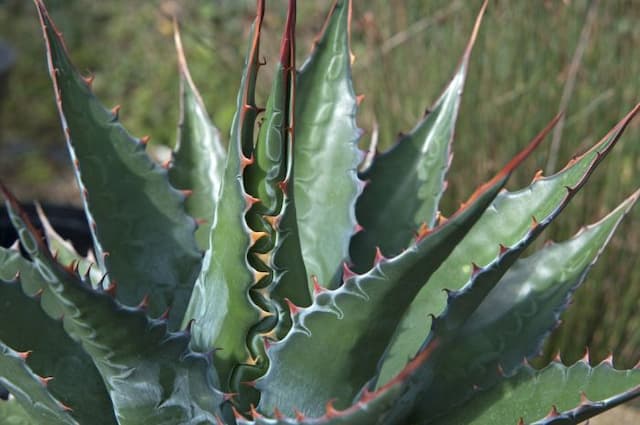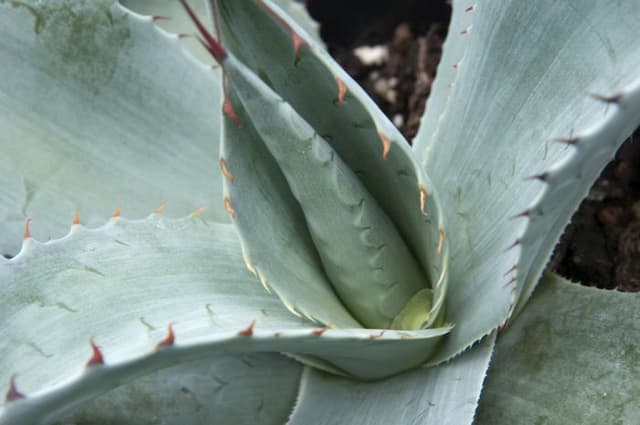Pineapple Lily Eucomis 'Playa Blanca'

ABOUT
Eucomis 'Playa Blanca', commonly known as Pineapple Lily, is a distinctive perennial plant that features a unique flower spike reminiscent of a pineapple's top. The Pineapple Lily is noted for its rosette of wide, strap-like leaves that lay out in a radial pattern from the center of the plant. These leaves are a lush green in color, providing a nice contrast to the striking white flowers that appear in the summer months. The floral display of the Pineapple Lily is particularly showy and consists of a dense column of star-shaped white flowers, each with a small green dot at the base. The flower spike is topped with a tuft of green leaf-like bracts that give it the pineapple-like appearance after which the plant is named. This top tuft is especially charming and gives the plant a whimsical, tropical flair. Texture is also a notable feature of this plant, with the flowers presenting a waxy appearance and the leaves sometimes showing a slightly rippled or crinkled edge, adding depth and interest to the overall presentation. Overall, the Pineapple Lily is prized in gardens and landscapes for its unique flowering structure and the tropical twist it brings to various settings.
About this plant
 Names
NamesFamily
Asparagaceae.
Synonyms
Pineapple Lily, Pineapple Flower.
Common names
Eucomis 'Playa Blanca'
 Toxicity
ToxicityTo humans
Pineapple lily (Eucomis 'Playa Blanca') is not typically considered highly toxic to humans, but it may cause mild gastrointestinal upset if parts of the plant are ingested, such as nausea, vomiting, or diarrhea. Contact with the sap can also cause skin irritation in some individuals with sensitive skin. It is advisable to not eat or handle the plant excessively without protective gloves, and to keep the plant out of reach of small children who may inadvertently ingest it.
To pets
Pineapple lily (Eucomis 'Playa Blanca') can be toxic to pets if they ingest it. In cats and dogs, symptoms of poisoning may include vomiting, diarrhea, drooling, and sometimes more severe reactions such as difficulty breathing or changes in heart rate if the ingestion is substantial. It is best to keep the plant out of reach of pets and to consult a veterinarian immediately if you suspect your pet has ingested any part of the pineapple lily.
 Characteristics
CharacteristicsLife cycle
Perennials
Foliage type
Deciduous
Color of leaves
Green
Flower color
White
Height
1-2 feet (30-60 cm)
Spread
1-2 feet (30-60 cm)
Plant type
Bulb
Hardiness zones
8
Native area
South Africa
Benefits
 General Benefits
General Benefits- Ornamental Value: Adds a unique and exotic appeal to gardens with its striking, white flower spikes resembling pineapple tops.
- Easy to Grow: Known for being low maintenance and easy to cultivate in a variety of garden settings.
- Drought Tolerant: Once established, it has a good tolerance for drought, reducing the need for frequent watering.
- Pollinator Attractant: Attracts a range of pollinators, including bees and butterflies, contributing to the health of the garden ecosystem.
- Long-Lasting Blooms: Produces long-lasting flowers during the summer, providing prolonged visual interest in the garden or when cut for arrangements.
- Versatile Planting: Suitable for planting in beds, borders, containers, and as a focal point in the landscape.
- Deer Resistant: Generally resistant to deer, making it a good choice for gardens in areas with high deer populations.
 Medical Properties
Medical PropertiesThis plant is not used for medical purposes.
 Air-purifying Qualities
Air-purifying QualitiesThis plant is not specifically known for air purifying qualities.
 Other Uses
Other Uses- Potpourri Ingredient: The dried flowers of the pineapple lily can add fragrance and visual interest to homemade potpourri mixes.
- Floral Art: Due to their unique appearance, the blooms can be dried and used in decorative floral arrangements and craft projects.
- Photography Subject: The distinct look of the pineapple lily makes it a great subject for botanical photographers and artists.
- Educational Tool: Pineapple lily can be used by educators to teach about plant morphology and pollination strategies.
- Garden Theme Settings: It can contribute to tropical or exotic themed garden designs due to its unique pineapple-like flower spikes.
- Collectors’ Specimen: Enthusiasts may cultivate the pineapple lily as a collector's item for a rare plant collection.
- Culinary Decoration: Although not edible, the flowers can be used as temporary, ornamental garnishes for plating high-end dishes.
- Fantasy Gardens: The pineapple lily's unusual appearance fits well in gardens designed with a fantasy or fairy tale theme.
- Water Garden Accent: When planted near water features, pineapple lilies can provide a dramatic, exotic look along the waterside.
- Container Gardening: They are suitable for planting in containers, allowing for the easy rearrangement of garden displays.
Interesting Facts
 Feng Shui
Feng ShuiThe Pineapple Lily is not used in Feng Shui practice.
 Zodiac Sign Compitability
Zodiac Sign CompitabilityThe Pineapple Lily is not used in astrology practice.
 Plant Symbolism
Plant Symbolism- Exotic Beauty: The Eucomis 'Playa Blanca', commonly known as the Pineapple Lily, possesses an exotic charm that symbolizes rare and striking beauty, resembling a tropical pineapple in flower form.
- Uniqueness: Its unusual appearance, with a tuft of leaf-like bracts atop its columnar flower spike, gives it a unique look, symbolizing individuality and standing out from the crowd.
- Prosperity: The Pineapple Lily is sometimes associated with prosperity and luxury due to its resemblance to the fruit which was once an exotic delicacy, representing wealth and opulence.
- Hospitality: Like the pineapple, the Pineapple Lily can represent hospitality and welcoming, suggesting a warm and generous nature.
 Water
WaterThe Pineapple Lily should be watered when the top 1-2 inches of soil feels dry to the touch, which may generally mean watering approximately every 7-10 days. However, this is highly dependent on environmental conditions such as temperature and humidity. Water the plant thoroughly until water runs out of the bottom of the pot, allowing excess water to drain away. Avoid letting the plant sit in water as this can lead to root rot. During active growth in spring and summer, the Pineapple Lily might require about one gallon of water every week or two, but always check the soil moisture level before watering.
 Light
LightPineapple Lily thrives in bright, indirect sunlight and should be placed in a location where it receives dappled sunlight or morning sun followed by afternoon shade. Direct midday sun may scorch the leaves, so it's best to avoid placing it in direct sunlight during the hottest part of the day. A spot near an east or west-facing window with filtered light would be ideal for this plant.
 Temperature
TemperatureThe Pineapple Lily prefers temperatures between 60 and 75 degrees Fahrenheit, making it ideal for typical indoor conditions. It can tolerate minimum temperatures down to 50 degrees Fahrenheit, but should be protected from temperatures below this range to avoid damage. The plant should not be exposed to temperatures exceeding 90 degrees Fahrenheit as it may cause stress and potentially harm the plant.
 Pruning
PruningPineapple Lily requires minimal pruning, primarily to remove any dead or damaged foliage and spent flower stalks to encourage healthy growth and appearance. The best time to prune is after the blooming season in late summer or early fall. Removing old flowers can also sometimes promote a second flush of blooms. Pruning should be done carefully with clean, sharp scissors or pruning shears to avoid damaging the healthy parts of the plant.
 Cleaning
CleaningAs needed
 Soil
SoilPineapple lily prefers well-draining soil with a mixture of two parts loam, one part sand or perlite, and one part peat or humus. Aim for a soil pH between 6.0 and 6.5 for optimal growth.
 Repotting
RepottingPineapple lilies should be repotted every two to three years to refresh the soil and accommodate bulb growth. Do so in the spring before active growth begins.
 Humidity & Misting
Humidity & MistingPineapple lily thrives in moderate humidity conditions but can tolerate a range. It is not particularly humidity-demanding, making it suitable for typical home environments.
 Suitable locations
Suitable locationsIndoor
Place in bright indirect light and water when topsoil is dry.
Outdoor
Plant in partial shade and well-draining soil; water regularly.
Hardiness zone
7-10 USDA
 Life cycle
Life cyclePineapple lily 'Playa Blanca' begins its cycle emerging from a bulb in spring, where foliage starts as a rosette of strappy leaves at the ground level. As the season progresses, a central flower spike develops, bearing a dense raceme of creamy-white, star-shaped flowers with a tuft of green bracts atop, resembling a pineapple, hence the name. After blooming in mid to late summer, the flowers eventually fade and the plant sets seed if pollinated. Throughout autumn, the foliage begins to yellow and die back as the plant enters dormancy. The bulb overwinters underground, where it conserves energy for the next growing season. In areas with cold winters, mulching or lifting and storing of the bulb may be necessary to protect it until the cycle repeats in spring.
 Propogation
PropogationPropogation time
Spring-Early Summer
The most popular method of propagation for the Pineapple Lily (Eucomis 'Playa Blanca') is through bulb offsets, also known as bulbils or daughter bulbs. This process usually takes place in late winter or early spring before the growing season begins. Gardeners typically wait until the mother bulb has produced small offsets, which can then be gently separated from the parent plant. Using a clean, sharp implement, these offsets are removed with a portion of the basal plate intact to ensure that they have sufficient energy to grow on their own. Once separated, the bulb offsets are planted in well-draining soil, approximately 4-6 inches deep (10-15 cm) and spaced about 8 inches (20 cm) apart, to allow for adequate room for growth. They will eventually develop into mature plants over the course of the growing season, following the same care requirements as the parent plant.









